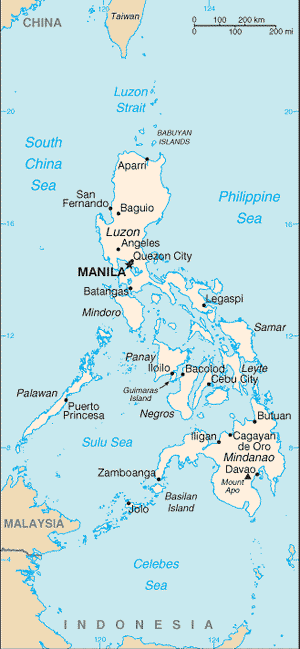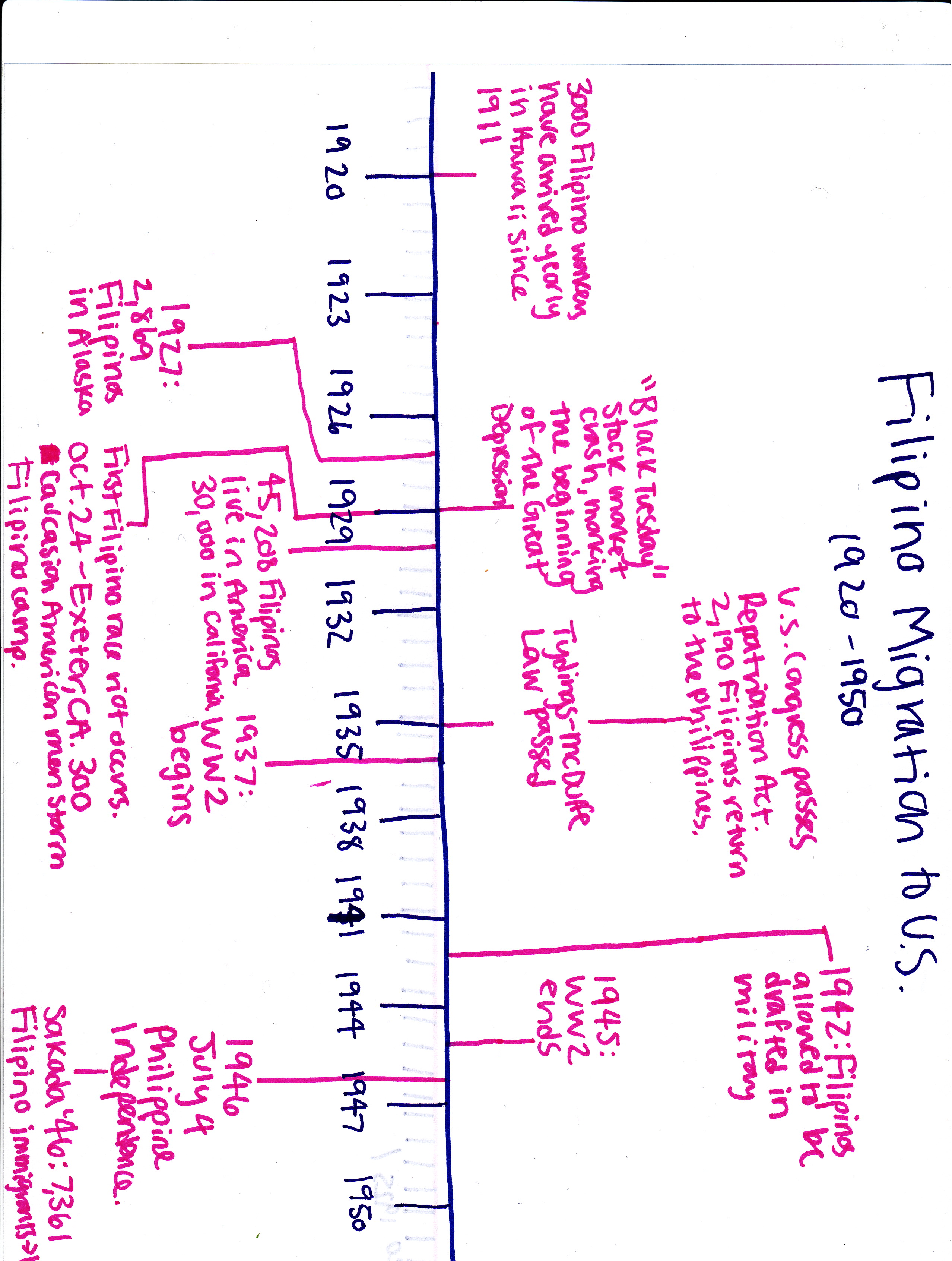The George Mason University campus can be considered
the epitome of the vast variety of people and cultures that are
attracted to come to the U.S. because of the allure of opportunity and
acceptance. However, upon arrival, realistically speaking, the dream is
nothing but a dream. Immigration laws, racial tensions, war. What one
may keep faith in, however, are the advancements that humankind is
possible of making. Despite how seemingly impossible it may look,
improvement is evident by looking at the progression of the past
century. The Filipino migration history is a prime example. Ranking as
one of the top 10 countries that send workers to foreign countries for
employment, the Philippines and the U.S. have had an interconnected
past in the last century. They provided a majority of the labor at
times for rigorous jobs across the country yet they faced racism and
manmade barricades that were intended to put an end to their presence
in America. However, they proved they could prevail and make their
efforts acknowledged.
Lisa O’Connor, a stay at home mother of four
that represents a diverse array of nationalities, is able to send her
children to get an education through an advantageous public school
system and enjoy her hobby of fossil hunting all because of her
father’s migration to America from the Philippines in the midst
of World War II. At the young age of 12 he and his family were a part
of the lucky wave of immigrants that left the war zone on a naval ship.
From 1920 to 1950, the O’Connors and many others arrived in the
U.S. in a populated wave of Filipinos avoiding death and poor economic
opportunity. An eagerness to work, study, and succeed still did not
prevent a plethora of obstacles from making the path to citizenship and
acceptance a long, winding road.
Seeking oversea jobs has been a prevalent part of
the Filipino culture in the past several decades. The Filipinos were
able to supply a hefty majority of laborers in the agricultural fields
of America during the 20th century. The first documented wave of
immigrants from the Philippines came in 1906 and landed in Hawaii. They
were mainly single men who were skilled to work in fields such as
agriculture.
 Map of the Philippines
Map of the Philippines
From 1911 to 1920 nearly 3000 Filipino workers arrived annually
in Hawaii (Castles 106). Anti-foreigner sentiments in the air made it a
difficult settlement for most families. America attempted to minimize
the allotted number of immigrants allowed into the U.S. by creating the
1924 Immigration Act. This act defined Filipinos as neither aliens nor
U.S. citizens, forcing them to work rigorous weeks in a country without
any benefits or acknowledgment. However employment prospects were not
hard to find at the time. The 1924 Immigration Act strictly prohibited
the Japanese from immigrating to the U.S. Due to this law, many
Japanese workers began to strike. The steep and sudden decrease in the
availability of Japanese labor worried the west coast agricultural
field. The Filipinos were very favorable for employment because they
were paid the least out of all the ethnic groups that worked in
agricultural fields at that time. Filipinos were employed in the states
of Hawaii and California as well as in the salmon cannery factories in
the Pacific Northwest and Alaska. This created tension in the U.S. as
people of other races faced fewer job opportunities.
An outbreak of racial riots began in 1929 on October 24th in Exeter,
California. “I was shocked. At the time, I didn’t feel I
was objectionable,” said Victor Merina, describing his childhood
during a period so plagued by racial tension (Asian American
Experiences in the United States, 46). On January 11th, 1930 the most
damaging riot took place in Watsonville, California.
The predominately Caucasian town of Watsonville was struggling with
major anti-Filipino sentiment for some time. The Northern Monterey
Chamber of Commerce helped create anti-Filipino resolutions. The riot
occurred when a group of Filipinos rented out a dance hall in Palm
Beach. Citizens were outraged by the fact that Filipino men would be
dancing with white women. A group of 500 Watsonville Americans raided
the dance club, beating the Filipinos viciously. One man died in the
raid. The Filipino headquarters were destroyed. Rioters attempted to
justify their actions by making such claims as the Filipinos were
undercutting wages (Migration Information).
Filipino presence caused so much controversy because they were taking
jobs from Americans. In addition, “The Filipino presence was
blamed for the decline of wages of fig, lettuce, and asparagus
harvesters” (Philippine History Site). Throughout California, the
contempt held by Americans for the Filipino’s presence ripped the
state apart. Laborers and lobbyists worked together to create a
resolution to ban Filipino immigration, just as the 1924 Immigration
Act restricted Japanese and Chinese migration. In 1929 California
called for congressional action. Coinciding with the start of the Great
Depression, the Repatriation Act was enacted in 1935. It was only
successful to an extent however, since most Filipinos chose to stay in
California. Only 2,190 Filipinos actually returned to the Philippines.
The Great Depression marked the height of Filipino exclusion in
America. During a time of intense racial terrorism and threatening
economical turmoil, Filipinos had an especially difficult time. Many
Filipinos were laid off in order to create jobs for Caucasian
Americans. In 1929 when the Great Depression began with the
“Black Tuesday” stock market crash, immigration from the
Philippines saw a significant decline. In 1934 the Tydings-McDuffe law,
also known as the Philippines Independence Act, set up the constitution
for a ten-year plan in which the Philippines gained freedom from the
U.S. The act renamed all Filipino-American residents as aliens and they
were no longer considered legally able to work in America.
The U.S. also instated 50 Filipino immigrants per year to fulfill a
quota. It was a long awaited move by much of the country. Several bills
had been presented to Congress to prevent Filipino presence in the U.S.
since the early 1920s. However both the Welch bill in 1928 and the
Shortridge bill in 1930 failed to pass, in turn failing to stop
Filipino immigration. It seemed that the only way to exclude Filipinos
would be to make the Philippines an independent nation. With the help
of Manuel L. Quezon, the leader of the Nationalist Party in the
Philippines, the act was revised to make the transition to independence
a peaceful one. These efforts were effective in ridding U.S. control of
naval bases in the Philippines, but life was still a struggle for
Filipinos living in America. The amount of impediments obstructing
Filipino’s quality of life in America continued to grow, which is
why so many Filipino immigrants would go back to the Philippines once
they had saved enough money.
In 1937 World War II began. This was a time of change for the entire
country. As the homeland had become a war zone, the U.S. once again
experienced an influx of Filipinos escaping the destruction and death
caused by massively disparaging weapons. Filipinos were banned from
joining the army until 1942 when Franklin D. Roosevelt declared them
able to be drafted. Many joined and fought in America and Asia and also
supported the U.S. in mobilization efforts.
Despite the brutality they faced while living in the country, Filipinos
saw an opportunity to put effort into bringing an end to a savage war.
Their dedication and support was not overlooked by surprised Americans
that were formerly so disgusted by their presence. The country as a
whole experienced a massive shift in attitude as the war continued. In
1940, a more clear-sighted America enacted the Nationality Act, which
allowed any noncitizens that served in the military to gain
citizenship.
In 1945 World War II ended, prompting the 1946 July 4th Philippine
Independence. After this momentous act was passed, 7361 Filipinos came
to Hawaii upon request for exemption from immigration laws in order to
keep plantations in working order. This is the last documented, massive
wave of immigration from the Philippines (Migration Information).
Without the presence of the Filipinos in America an entire century of
history would be drastically different. They shaped the country,
providing the base of labor for years in the agricultural department.
Their dedication to stay and prevail in America is so admirable as they
faced such severe obstructions of civil rights with growing racial
tensions. Their passive aggressive behavior was a sign of dignity as
they never stooped down to the level of destroying American land.
Without their presence, America would not have become the country it is
today. Lisa O’Connor and her family are living proof of how their
efforts paid off in order for their relatives to live peacefully and
happily in the states. Their caliber under such circumstances continues
to be respected and admired throughout history.

Bibliography
1. H. Brett Melendy. “Filipinos in the United States”
The Pacific Historical Review, Vol. 43, No. 4. (Nov., 1974), pp. 520-547.
2. Jean Lee, Joann Faung. Asian American Experiences in the United States. Jefferson, NC: McFarland & Company , 1991.
3. Burma, John H. . "The Background of the Current Situation of Filipino-Americans." Social Forces 10-1951: pp. 42-48.
4. Bulosan, Carlos. America is in the Heart: A Personal History. New York: Harcourt, Brace & Company, 1941.
5. Villamin, Vicente. Filipinos in America." Washington Post 07-05-1932: pp. 6.
6. M.B. Asis, Maruja. "The Philippines' Culture of Migration." Migration Information Source Jan 2006. Accessed Feb 01 2008.
.
7. Table- http://opmanong.ssc.hawaii.edu/filipino/wwii.html



